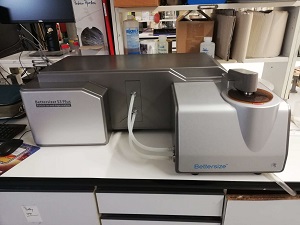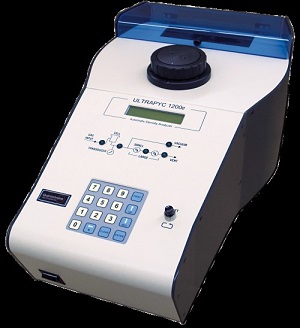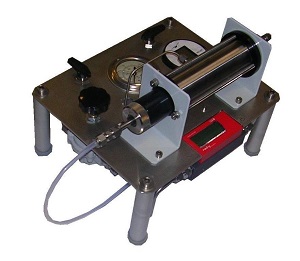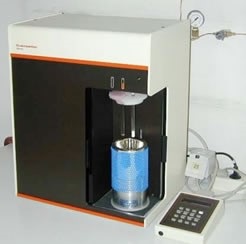Petrophysical Analysis
Contact
Dr. Bettina Scheu
Dr. Ulrich Küppers
Laboratory Phone: +49 89 2180 4661
Equipment
• Centrifuge
• Furnace I (60*40*40 cm, 1100°C)
• Furnace II with vacuum pump (40*40*25 cm, up to 200°C)
• Grain-size and particle shape analysis (Bettersizer)
• Helium Pycnometer (Quantachrome)
• Rotational Evaporator with Waterbath B-480 (Fa. Büchi)
• Permeability (GPE)
• Surface Area Analyzer (Micromeritics)
• Vp/Vs velocity
Grain-size and particle shape analysis (Bettersizer S3 Plus – 3P Instruments)
The particle size and shape analyser measures particles in dispersion by combining the methods of static light scattering (based on the Mie theory) and dynamic image analysis. By combining those two different methods, size and shape in the range 0.01 – 3500 µm can be quantified. The shape analysis is performed by two high-speed cameras (0.5x and 10.0x magnification) which allows the characterization of samples even within a broad grain size distribution.

With the additional dispersion unit (300 ml), measurements can be performed in all common solvents e.g. water and ethanol. The user can expose the sample to controlled stirring conditions and ultrasonic pulses before the measurement. Dry sample mass required is grain-size dependent and are between <0.1g (fine) and 2-3 g (coarse).
Helium Pycnometer (Quantachrome)
The Ultrapyc 1200e Helium gas pycnometer is used for the measurement of true density and volume of solids. The pycnometer precisely measures the gas volume displaced by sample that is not reached by pressurized helium gas. Together with a precise input of the mass of the sample (0.1 mg), it can be used to obtain the density of the non-connected fraction of the sample with a precision of 0.0001 g/cm3. This device allows then to know the density and volume of powders as well as non-symmetric solid samples. When known the geometric volume of the sample, e.g. for cylindrical samples, its connected porosity can be calculated. Also, total and isolated porosity can be calculated by measuring the powder volume after crushing the sample.

This device is equipped with three interchangeable chambers that allow precise measurements of samples with volumes between 0.1 - 135 cm3, providing an accuracy of ±0.03 %. The analysis is completely automated after calibration and sample placement. Maximum sample size is limited to 62mm in height and 40 mm in diameter.
Permeability measurement (Vinci)
The steady-state gas permeameter (GPE) accurately determines the permeability of cylindrical samples (up to 30mm diameter) at ambient temperature and moderate confining pressure by virtue of the steady state method. The latter implies a constant flow rate across the sample. Gas can be injected over a wide range of pressures and flow rates. The core inlet pressure is continuously monitored by an inline pressure transducer while the gas flow rate is reported by a high-grade mass flow meter. The apparatus can be used with both consolidated and unconsolidated core samples previously prepared in metal or plastic sleeves with screens at the ends. An Excel spreadsheet calculation template allows for calculation of parameters and also calibration data.

Our GPE has been implemented with two flowmeters for low (0.4-10 ml/min) and high (10-1000 ml/min) ranges. Pressure evolution in time is monitored using a LabVIEW (National Instruments) application, tailored for the two different flowmeters.
FEATURES:
Permeability range: 0.01 md (10-17m2) to 1 Darcy (10-12m2)
Flow Pressure: 0 to 100 psi
Gas flow: 0-1000 ml/min
Temperature: ambient
Temperature accuracy: +/- 0.1 °C
Pressure transducer accuracy: 0.1% F.S.
Flow accuracy: 1 % F.S.
Nitrogen supply: 250 psi
Power: 110-220 VAC, 50 or 60 Hz
Surface area analysis (Micromeritics)
The Gemini gas sorption device allows for measuring the specific surface area (m2/g) of unconsolidated powder samples as well as cylindrical samples (up to 30mm in length and up to 25mm in diameter). By default, Argon gas is used. The device determines single- and multipoint BET and Langmuir surface areas; total pore volume, and micropore analysis by the t-method can be obtained when operating with Nitrogen gas.






